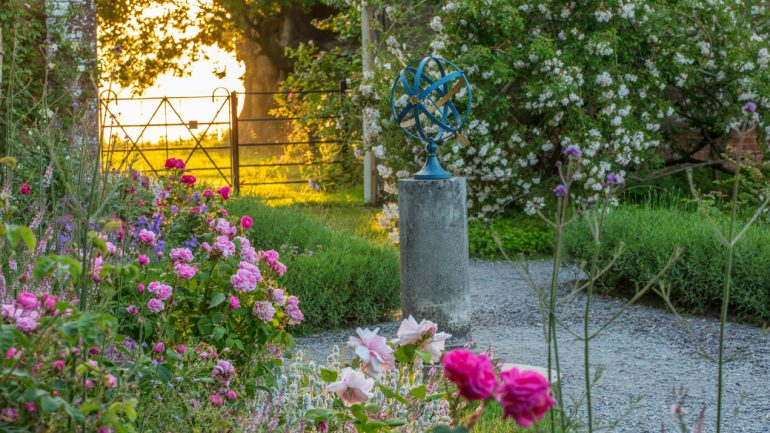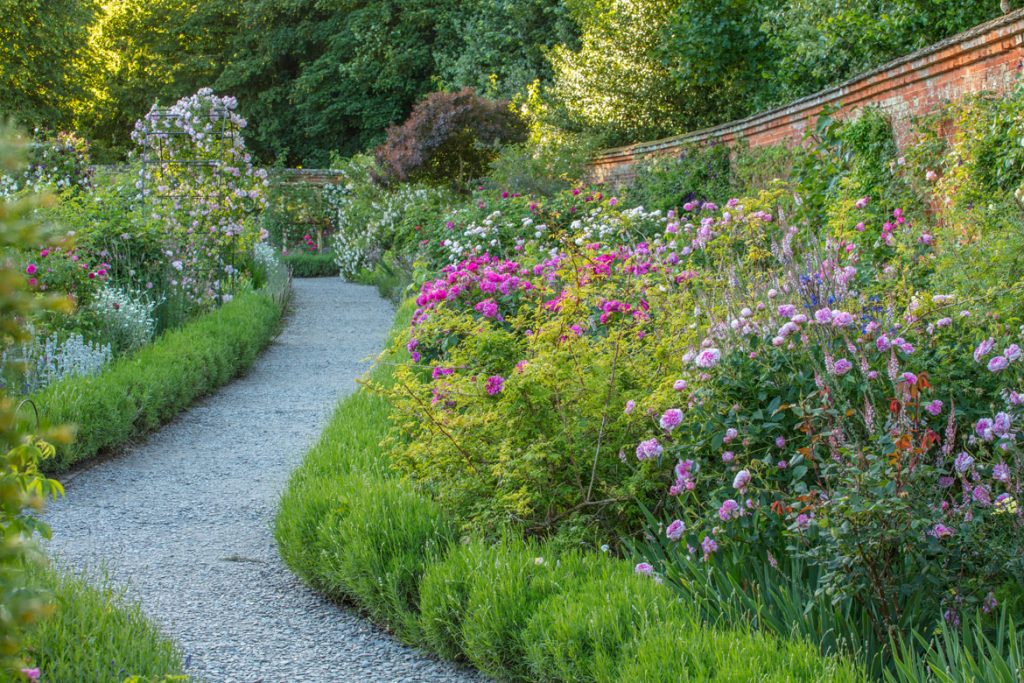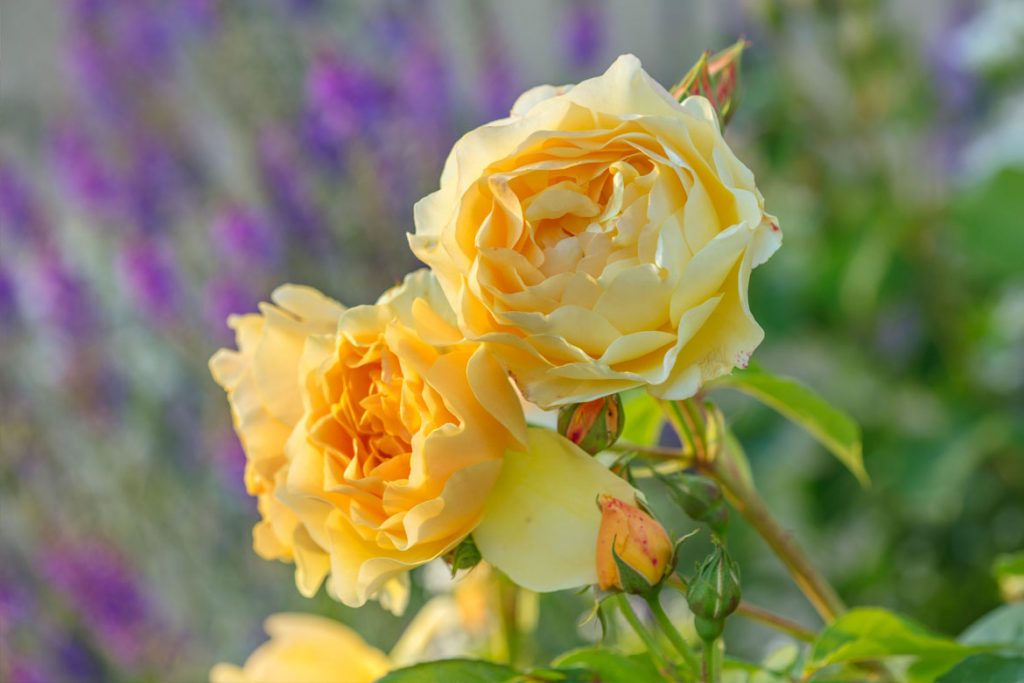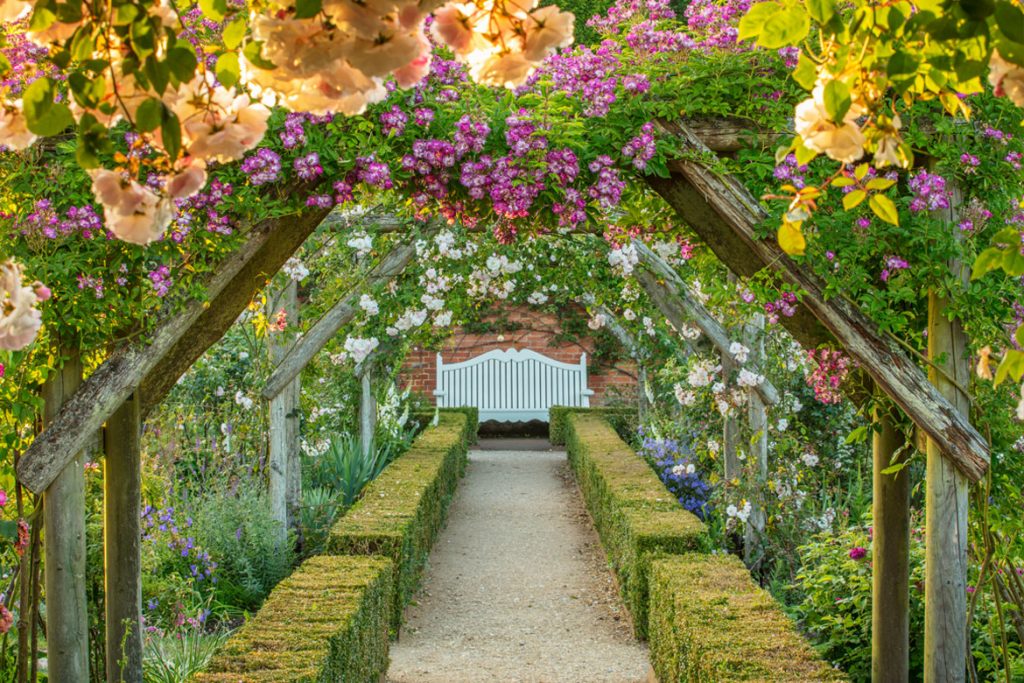Evening openings in June offer more opportunities to experience the National Collection of old-fashioned roses at their peak
The walled garden at Mottisfont is filled with fragrance and colour from thousands of roses in early summer. The National Trust property is home to the National Collection of pre-1900 old-fashioned roses, which reach their peak in early summer. Unlike modern species, old-fashioned roses tend to flower just once a year, so their blooming season is an extraordinary annual sight, attracting thousands of visitors.
Mottisfont is offering extended opening hours on some evenings during June, giving you more opportunities to enjoy these spectacular flowers. On Thursdays, Fridays and Saturdays 1 – 30 June the gardens will be open until 8pm (last entry into property 7pm, house closes at normal time of 5pm), with live jazz from the FB Pocket Orchestra on some evenings.
“As Mottisfont’s new Head Gardener, I’m really excited to experience rose season for the first time,” says Tina Chillingworth. “I’m waiting in anticipation for the rose gardens to reveal their array of bright colours and bouquets. The team have meticulously pruned and tied in five hundred roses and nurtured their progress through a year of challenging weather conditions. We look forward to welcoming all visitors in sharing our enjoyment of the sensory rose garden experience.
Pictured above: Credit National Trust Images – Clive Nichols
Credit National Trust Images – Clive Nichols
“Personally, I feel the early mornings and evenings offer the most captivating moments, so I encourage visitors to take advantage of our late opening times. Exciting times!”
Over 500 varieties of rose bloom in Mottisfont’s walled gardens, including Rosa ‘Souvenir de la Malmaison’ – a sumptuous pale pink bourbon rose inspired by the Empress Josephine’s famous garden – and delicate China and tea roses in shades of cream, pink and red.
Ancient varieties include Rosa ‘Gallica Officinalis’, a light crimson and deeply scented shrub brought to England from Persia by the Crusaders, and the highly scented ‘Quatre Saisons’, an autumn damask which was grown by the Romans.
Credit National Trust Images – Clive Nichols
The rose gardens were created by Graham Stuart Thomas – one of the most important figures in 20th-century British horticulture – in the 1970s. Mottisfont’s walled gardens were chosen to house many varieties of rose that may otherwise have been lost.
With an artist’s eye and consummate knowledge, Graham Stuart Thomas designed a garden that would combine roses with a mix of perennials to give a season-long display.
Visitors enter through Mottisfont’s recently revived Kitchen Garden, where two beds of eleven different types of rose provide a modern introduction to the hundreds found beyond. Walkway arbours are decorated with four varieties of climbing rose, based on Graham Stuart Thomas’s choice of companion roses. Hedging of Rosa rugosa ‘Rubra’ leads you into these arbours, mirroring the entrance to the central garden.
Within the central garden, deep box-lined borders are full of rambling roses, while climbing varieties are trained on the high brick wall behind. The main paths crossing the site converge on a central round pond and fountain, surrounded by eight clipped Irish yews.
Either side of the historic central pathway are two deep herbaceous flower beds, brimming with plants chosen to complement and underplant the roses. Agapanthus, geraniums and peonies mingle with pinks, lilies, phlox and nepeta. The centres of the borders are a mass of soft blues, pinks and whites, whilst stronger yellows, oranges and dark pinks draw the eye along the length of the border.
Credit National Trust Images – James Dobson
These borders also extend the flowering season, providing colour, shape and scent before the roses bloom and after their petals fall.
The northern section of the walled garden, with its wide paths, is deliberately planted with a ‘cool’ colour palette to provide a counterpoint to the central rose garden.
From 14-18 June this year an added attraction will be rose displays and special guest speakers as part of the National Trust’s second plant ‘Monograph’, where horticulturists will gather to study and discuss the genus Rosa. A marquee near the walled gardens will display stands from various rose breeders and information from the historic rose society.
Mottisfont’s gardeners take great pride in looking after this world-class rose garden. To prepare for the summer show, over 40 tonnes of Mottisfont’s homemade compost is spread throughout the walled garden, feeding the soil below.
The gardeners don’t tend to dead-head these unique roses, which is a surprise to some visitors. Most of the old-fashioned types only flower once a year, and afterwards produce ornamental fruit or ‘hips’, which, as well as brightening the garden in autumn, provide local birds with an important source of winter food. The team remove the spent blooms of the repeat flowering roses by cutting the stem back to a healthy new bud which will encourage them to keep flowering.
Many of the roses which bloom within the gardens can be found for sale within Mottisfont’s plant centre, and visitors can try rose-flavoured ice cream inspired by Mottisfont, created by Hampshire-based ice cream makers Jude’s.
Credit National Trust Images – Clive Nichols
National Trust members, Art Fund members and under 5s get free entry to Mottisfont, otherwise peak admission prices apply from 10am-3pm from 29 May – 2 July. Standard admission applies from 3pm onwards, including the evening openings.
For more information about Mottisfont, visit www.nationaltrust.org.uk/visit/hampshire/mottisfont or call 01794 340757.
Words by the National Trust






Leave a Reply